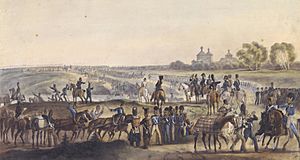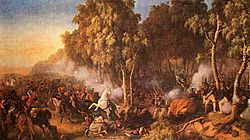First Battle of Krasnoi facts for kids
Quick facts for kids First Battle of Krasnoi |
|||||||
|---|---|---|---|---|---|---|---|
| Part of the French invasion of Russia | |||||||
 The crossing of the Dniepr by Christian Wilhelm von Faber du Faur |
|||||||
|
|||||||
| Belligerents | |||||||
| Commanders and leaders | |||||||
| Strength | |||||||
| 13,000 | 6,000-7,000 | ||||||
| Casualties and losses | |||||||
| 500 killed, wounded or captured | 1,500 killed, wounded or captured | ||||||
The First Battle of Krasnoi was a fight that happened on August 14, 1812. It was part of the larger French invasion of Russia. In this battle, French troops led by Michel Ney fought against Russian troops led by Dmitry Neverovsky. The French won this battle. However, the Russian soldiers were able to retreat in an organized way towards the city of Smolensk.
Getting Ready for Battle
Before the battle, a Russian general named Bagration sent more soldiers to Neverovsky. He also gave Neverovsky some cavalry, which are soldiers who fight on horseback. Neverovsky's job was to protect the town of Krasnoi. He especially needed to guard the area to the west, towards Orsha. This was important to slow down the French advance.
The Battle Begins
French General Ney attacked Krasnoi and pushed Neverovsky's troops out of the town. The French also managed to capture some of the Russian cannons. These were the first captured weapons of the entire French invasion.
Neverovsky quickly gathered his 6,000 to 7,000 soldiers. He arranged them into a large square formation. This formation was very strong, and Ney's cavalry could not break through it. The Russian square then moved across the open field. They even managed to cross a wooden fence, which Ney's cavalry could not follow. Because of this clever move, Neverovsky's troops were able to escape in good order. They left behind about 1,500 soldiers who were either killed, wounded, or captured.
What Happened Next
After the battle, General Neverovsky and his remaining troops returned to Smolensk. He reported what had happened. Just two days later, a much bigger fight called the Battle of Smolensk began.
More to Explore


